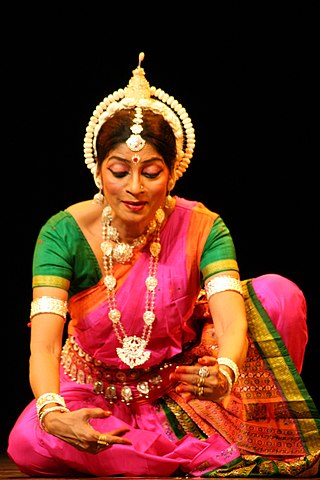
Kelucharan Mohapatra was a legendary Indian classical dancer, guru, and exponent of Odissi dance, who is credited with the revival and popularizing of this classical dance form in the 20th century. He is the first person to receive the Padma Vibhushan from Odisha.

Odissi music is a genre of classical music in India, originated from the eastern state of Odisha. The traditional ritual music for the service of Lord Jagannatha, Odissi music has a history spanning over two thousand years, authentic sangita-shastras or treatises, unique Ragas & Talas and a distinctive style of rendition.

Shriram Bharatiya Kala Kendra (SBKK) is an Indian cultural institution which runs a school for music, dance and performing arts in New Delhi. It was founded by Sumitra Charat Ram in 1952, and imparts training in Indian classical dance styles and music, including Kathak, Bharatanatyam, Odissi, Chhau, Hindustani Classical music, both Vocal and Instrumental. Its associated organisation is the Shri Ram Centre for Performing Arts at Safdar Hasmi Marg, in the Mandi House area, the cultural hub of Delhi, the centre includes a theater for the performing arts, a theatre repertory company and an acting school.

Guru Mayadhar Raut is an Indian classical Odissi dancer, choreographer and Guru.
Ileana Citaristi is an Italian Odissi and Chhau dancer, and dance instructor based in Bhubaneswar, India. She was awarded the 43rd National Film Awards for Best Choreography for Yugant in 1995 and became, in 2006, the first dancer of foreign origin to be conferred the Padma Shri for her contributions to Odissi.
Kumkum Mohanty is an Odissi dancer.

Kasturi Pattanaik is a pioneering Odissi dance exponent, performer, choreographer, teacher, trainer and music composer from India.

Geeta Mahalik is an Indian Odissi dancer. The Government of India honoured her with the Padma Shri in 2014 for her services to the field of art and culture.
Deba Prasad Das was an Indian classical dancer, considered by critics and connoisseurs as one of the four first generation gurus of the Indian classical dance form of Odissi. His Odissi style is robust and unique. He was a recipient of the 1977 Sangeet Natak Akademi Award. and 1974 Odisha Sangeet Natak Akademi Award.
Md. Sikandar Alam was a playback singer in Odisha film industry. He is sometimes called the Salabega of modern Odisha.

Aruna Mohanty is an Odissi dancer, choreographer and guru. She is currently the Secretary of the Orissa (Odisha) Dance Academy. She has received a number of awards for her work, including the Padmashree award.

Banamali Maharana was an Indian percussionist who played Mardala.

Utkal Sangeet Mahavidyalaya is a performing arts-cum-educational institution in Bhubaneswar, Odisha, India.

PanditGopal Chandra Panda is a Guru of Odissi classical music, vocalist, researcher and composer. A disciple of Singhari Shyamsundar Kar, he has authored several books such as Odissi Raga Ratnabali & Odissi Raga Darpana, and is acclaimed for his efforts to collect & document several traditional Odissi ragas from the hinterlands. Panda served as a lecturer and head of department in the Utkal Sangeet Mahavidyalaya for nearly three decades. He has performed in music festivals across the country and is the founder of the Gopal Panda Odissi Academy. In 2011, Panda received the Sangeet Natak Akademi Award for his contributions to Odissi music.

PanditRamhari Das is a leading singer, composer, musicologist and Guru of Odissi music. Known for his renditions, compositions, lecture-demonstrations and writings, Das has served as a professor and led the Odissi vocal department in prominent musical institutions of Odisha, including the Utkal Sangeet Mahavidyalaya and the Utkal University of Culture. He is the founder of Ramhari Das Odissi Gurukula at Biragobindapur, Puri. For his contributions to Odissi music, Das received the Sangeet Natak Akademi award in 2008.

Dhaneswar Swain is an exponent and Guru of the Odissi Mardala, the traditional percussion instrument of Odissi music. He is known for his rhythmic compositions and fingering techniques, as well as his efforts to promote solo Mardala recitals and group presentations combining traditional percussive instruments of Odisha. He is the founder of Vadya Vani Gurukula, an institution for training and research in Odissi Mardala and other traditional percussion instruments of Odisha.
Gujjari is a rāga belonging to the tradition of Odissi music. Falling under the meḷa Karnāta, the raga uses komala gandhara, komala dhaibata and komala nisada swaras and is traditionally associated with the karuṇa rasa. The raga is mentioned in treatises such as the Gita Prakasa and Sangita Narayana. Among its angaragas, Mangala Gujjari is most prominent and has been used by Jayadeva in his Gita Govinda, alongside Gujjari itself.
Ramakeri is a rāga belonging to the tradition of Odissi music. Falling under the meḷa Barādi, the raga uses komala rusabha, komala dhaibata and tibra madhyama swaras and is traditionally associated with the karuṇa rasa. The raga is mentioned in treatises such as the Gita Prakasa and Sangita Narayana. This raga has been used by the 12th-century Odia composer Jayadeva in his Gita Govinda.
Baradi is a rāga belonging to the tradition of Odissi music. Falling under the meḷa Barādi, the raga uses komala rusabha, komala dhaibata and tibra madhyama swaras and is traditionally associated with the karuṇa rasa. The raga is mentioned in treatises such as the Gita Prakasa and Sangita Narayana. This raga has been used by the 12th-century Odia composer Jayadeva in his Gita Govinda along with its angaraga Desa Barādi.
Sri is a rāga belonging to the tradition of Odissi music. Falling under the meḷa of the same name, the raga uses komala nisada swara and is traditionally associated with the melancholic karuna rasa. The raga is mentioned in treatises such as the Gita Prakasa and Sangita Narayana. Among its angaragas, Dhanasri, Bangalasri, Karunasri, Malasri, Madhusri, Dakhinasri are well-known.











